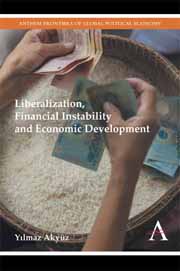Book contents
- Frontmatter
- Dedication
- Contents
- Introduction
- PART ONE LIBERALIZATION, STABILITY AND GROWTH
- Chapter I Financial Liberalization: The Key Issues
- Chapter II Managing Financial Instability in Emerging Markets: A Keynesian Perspective
- Chapter III From Liberalization to Investment and Jobs: Lost in Translation
- Chapter IV Exchange Rate Management, Growth and Stability: National and Regional Policy Options in Asia
- Chapter V Reforming the IMF: Back to the Drawing Board
- PART TWO THE GLOBAL ECONOMIC CRISIS AND DEVELOPING COUNTRIES
Chapter I - Financial Liberalization: The Key Issues
from PART ONE - LIBERALIZATION, STABILITY AND GROWTH
- Frontmatter
- Dedication
- Contents
- Introduction
- PART ONE LIBERALIZATION, STABILITY AND GROWTH
- Chapter I Financial Liberalization: The Key Issues
- Chapter II Managing Financial Instability in Emerging Markets: A Keynesian Perspective
- Chapter III From Liberalization to Investment and Jobs: Lost in Translation
- Chapter IV Exchange Rate Management, Growth and Stability: National and Regional Policy Options in Asia
- Chapter V Reforming the IMF: Back to the Drawing Board
- PART TWO THE GLOBAL ECONOMIC CRISIS AND DEVELOPING COUNTRIES
Summary
Introduction
In recent years financial policies in both industrial and developing countries have put increased emphasis on the market mechanism. Liberalization was partly a response to developments in the financial markets themselves: as these markets innovated to get round the restrictions placed on them, governments chose to throw in the towel. More importantly, however, governments embraced liberalization as a doctrine.
In developing countries, the main impulse behind liberalization has been the belief, based on the notion that interventionist financial policies were one of the main causes of the crisis of the 1980s, that liberalization would help to restore growth and stability by raising savings and improving overall economic efficiency; greater reliance on domestic savings was necessary in view of increased external financial stringency. However, these expectations have not generally been realized. In many developing countries, instead of lifting the level of domestic savings and investment, financial liberalization has, rather, increased financial instability. Financial activity has increased and financial deepening occurred, but without benefiting industry and commerce.
In many industrial countries the financial excesses of the 1980s account for much of the sharp slowdown of economic activity in the 1990s. Financial deregulation eased access to finance and allowed financial institutions to take greater risks. The private sector accumulated large amounts of debt at very high interest rates in the expectation that economic expansion would continue to raise debt servicing capacity while asset price inflation would compensate for high interest rates.
- Type
- Chapter
- Information
- Publisher: Anthem PressPrint publication year: 2014



